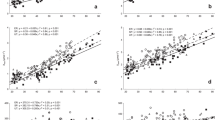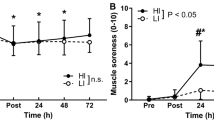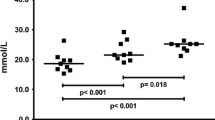Summary
During exhausting exercise adenylate kinase in the muscle cells is activated and a degradation of adenosine 5′-diphosphate occurs. Consequently, degradation products of adenosine 5′-monophosphate including hypoxanthine and uric acid, accumulate in plasma. The aim of this study was to compare the concentration changes of hypoxanthine and uric acid in plasma following running of varying duration and intensity. In addition, plasma creatine kinase activity was measured to assess the possible relationship between metabolic stress and protein release. Four groups of competitive male runners ran 100 m (n = 7), 800 m (n = 11), 5000 m (n = 7) and 42 000 m (n = 7), respectively, at an exhausting pace. Subsequent to the 100 m event (mean running time 11 s) plasma concentrations of hypoxanthine and uric acid increased by 364% and 36% respectively (P<0.05), indicating a very high rate of adenine nucleotide degradation during the event. Following the 800-m event (mean running time 125 s), hypoxanthine and uric acid concentrations had increased by 1598% and 66%, respectively (P<0.05). Both the events of longer duration, 5000 m and 42 000 m, also caused a significant increase in plasma concentration of hypoxanthine (742% and 237% respectively,P< 0.05) and plasma uric acid (54% and 34% respectively,P<0.05). Plasma activities of creatine kinase were significantly increased at 24 h only following the 5000 m and 42 000 m events (64% and 1186% respectively,P<0.05). Changes in plasma creatine kinase activity showed no correlation with changes in plasma concentration of either hypoxanthine or uric acid for the 5000 m and 42000 m events (r=0.00–0.45,P>0.05). These findings suggest that metabolic stress induced by exhausting exercise cannot be considered an important factor for the release of intracellular proteins. It was, furthermore, concluded that the rate of elimination of adenine nucleotides from cells was markedly elevated with the increasing intensity of exercise and only moderately affected by the duration of running.
Similar content being viewed by others
References
Apple FS, Hellsten Y, Clarkson PM (1988) Early detection of skeletal muscle injury by assay of creatine kinase isoforms in serum after acute exercise. Clin Chem 34:1102–1104
Armstrong RB (1986) Muscle damage and endurance events. Sports Med 3:370–381
Åstrand PO, Rodahl K (1986) Textbook of work physiology. McGraw-Hill, New York
Cheetham ME, Boobis LH, Brooks S, Williams C (1986) Human muscle metabolism during sprint running. J Appl Physiol 61:54–60
Hellsten-Westing Y, Ekblom B, Sjödin B (1989) The metabolic relation between hypoxanthine and uric acid in man following maximal short distance running. Acta Physiol Scand 137:341–345
Janssen GME, Degeenaar CP, Menheer PPCA, Habets HML, Geurten P (1989) Plasma urea, creatinine, uric acid, albumin, and total protein concentrations before and after 15-, 25-, and 42-km contests. Int J Sports Med 10:S132-S138
Jarasch E-D, Grund C, Bruder G, Heid HW, Keenan TW, Franke WW (1981) Localization of xanthine oxidase in mammary-gland epithelium and capillary endothelium. Cell 25:67–82
Ketai LH, Simon RH, Kreit JW, Grum CM (1987) Plasma hypoxanthine and exercise. Am Rev Respir Dis 136:98–101
Nevill ME, Boobis LH, Brooks S, Williams C (1989) Effect of training on muscle metabolism during treadmill sprinting. J Appl Physiol 67:2376–2382
Newham DJ, Jones DA, Edwards RHT (1983) Large delayed plasma creatine kinase changes after stepping exercise. Muscle Nerve 6:380–385
Noakes TD (1987) Effect of exercise on serum enzyme activities in humans. Sports Med 4:245–267
Norman B, Sollevi A, Kaijser L, Jansson E (1987) ATP breakdown products in human skeletal muscle during prolonged exercise to exhaustion. Clin Physiol 7:503–510
Rosalki SB (1967) An improved procedure for serum creatine phosphokinase determination. J Lab Clin Med 69:696–701
Roy RS, McCord JM (1983) Superoxide and ischemia. In: Greenwald RA, Cohen G (eds) Conversion of xanthine dehydrogenase to xanthine oxidase. Oxy radicals and their scavenger systems, vol II. Cellular and medical aspects. Elsevier, New York
Sjödin B, Hellsten-Westing Y (1990) Changes in plasma concentrations of hypoxanthine and uric acid in man with short distance running at various intensities. Int J Sports Med 11:493–495
Ström G (1949) The influence of anoxia on lactate utilization in man after prolonged muscular work. Acta Physiol Scand 17:440–451
Sutton JR, Toews CJ, Ward GR, Fox IH (1980) Purine metabolism during strenuous muscular exercise in man. Metabolism 29:254–260
Tiidus PM, Ianuzzo CD (1983) Effects of intensity and duration of muscular exercise on delayed soreness and serum enzyme activities. Med Sci Sports 15:461–465
Wung WE, Howell SB (1980) Simultaneous liquid chromatography of 5-fluorouracil, uridine, hypoxanthine, xanthine, uric acid, allopurinol and oxipurinol in plasma. Clin Chem 26:1704–1708
Author information
Authors and Affiliations
Rights and permissions
About this article
Cite this article
Hellsten-Westing, Y., Sollevi, A. & Sjödin, B. Plasma accumulation of hypoxanthine, uric acid and creatine kinase following exhausting runs of differing durations in man. Europ. J. Appl. Physiol. 62, 380–384 (1991). https://doi.org/10.1007/BF00634977
Accepted:
Issue Date:
DOI: https://doi.org/10.1007/BF00634977




